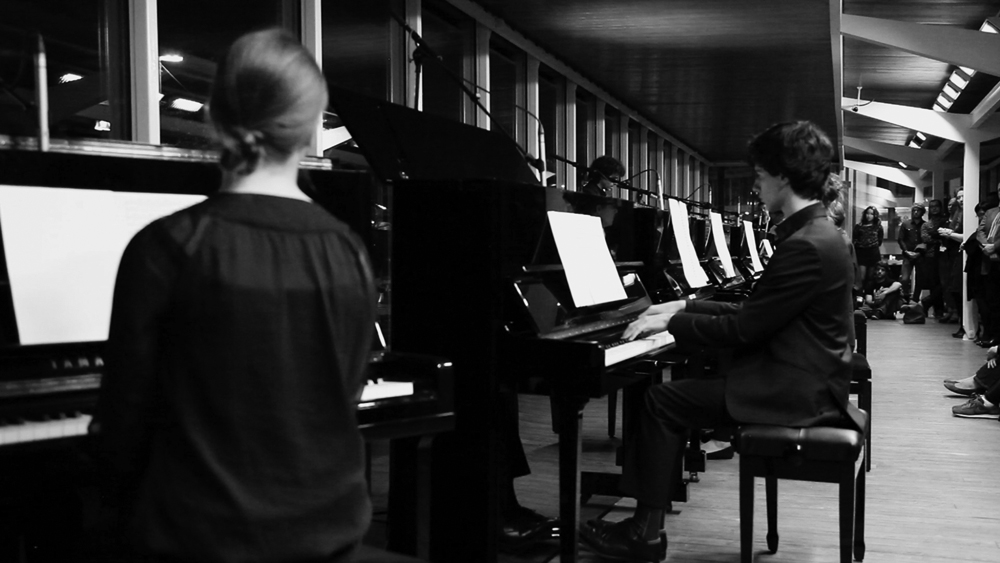In one cavernous space, the heads and shoulders of audience members at “Goldberg Experienced.04”—an eight piano rendition of Bach’s “Goldberg Variations”—sway to different rhythms. For every individual, it may be a specific piano that resonates with them, or a single note appearing once in the hour-long piece, or a pattern subtly detected from beginning to end. Bach’s original “Goldberg Variations” is a compositional labyrinth, and with the interpretation of artist Patrick Bernatchez, the walls of the harmonic maze grow taller and the deceptions more cunning. Bernatchez’s concert was just one part of a multimedia examination of temporality in music at the Musée d’Art Contemporain (MAC) museum last Sunday.
The masterstroke of Bach’s 1741 piece, intended for the harpsichord, is in the name: “Variations.” The composition is cyclical, with 30 variations on the same bass line and almost the same harmonic structure. It is still lauded today for its highly emotional effect within a mathematical structure. Although only an estimated 100 copies of the print music were originally released—sound recording wasn’t invented until over a century later—“Goldberg Variations” has become one of the best-selling pieces of classical music to date.
Bernatchez is someone whose fascination with the deceptively simple composition endures. His continuation of the legacy, however, is more complex than any other performance. In the MAC basement, eight glittering black-and-gold pianos and their young players are not mimickers playing a tribute show to Bach. If they mimic anything, it is the “Goldberg Variations” on scratched vinyl.
“Goldberg Experienced.04” is part of a larger piece. Two flights up the stairs of the museum is the temporary exhibition space titled “Patrick Bernatchez: Les temps inachevés.” The show examines the space-time continuum, time travel, decomposition, and the cycle of seasons and lives. There is a lot of black and stainless steel. With hours of looped videos, drawings of distorted women inspired by mold stains, and headphone listening stations, the space becomes a corner of cosmic dark matter. In the piece “Goldberg Experienced.03,” eight altered vinyl recordings of Bach’s composition, as performed by Glenn Gould in 1981, play simultaneously. As the records were altered by natural wear, the product lost some human control. Their collective sound was transposed by composer Patrice Coulombe into a piece for eight pianos.
So, then, is the performance in the museum basement a new piece? Or is it the fourth version of the original, as Bernatchez indicates in its name? It is the blur of authorship and creative process that fits with “Les temps inachevés.” The ideas of cyclicity are conveyed by Bernatchez visually in the exhibition, and “Goldberg Experienced.04” is a completely immersive audio component. At times ,the high notes drip, accompanying Bernatchez’s video of a leaking ceiling in the Fashion Plaza industrial building. The simulation of rapidity by eight pianos, a sound unachievable by one player, connotes the artist’s graphite and ink depictions of decay, like growth on fast-forward. Just as the individual pieces of “Les temps inachevés” require conceptual explanation, “Goldberg Experienced.04” has strength in instrumental numbers. Whether the sound is booming or twinkling, it becomes superlative when the eight pianos are synchronized.
Despite a thick history of connections and inspiration, “Goldberg Experienced.04” feels youthful. This is due to the near total dominance of the joyful G-major in Bach’s composition, and to the curation of Bernatchez and Coulombe. When listeners are drifting 40 minutes into a purposely repetitive and dragging piece, the cacophony comes to a clattering halt and only one player remains, notes light and high. The realization comes then to listen closely for what is hiding below the sound’s surface.
As the show ends, another layer is complete: This group of listeners on Sunday in the basement of the museum. The performance of Bach’s piece will never be exactly the same. Although it is another question, of course, if that was recorded.
You can learn more about Patrick Bernatchez’s work on his website: www.patrickbernatchez.org








